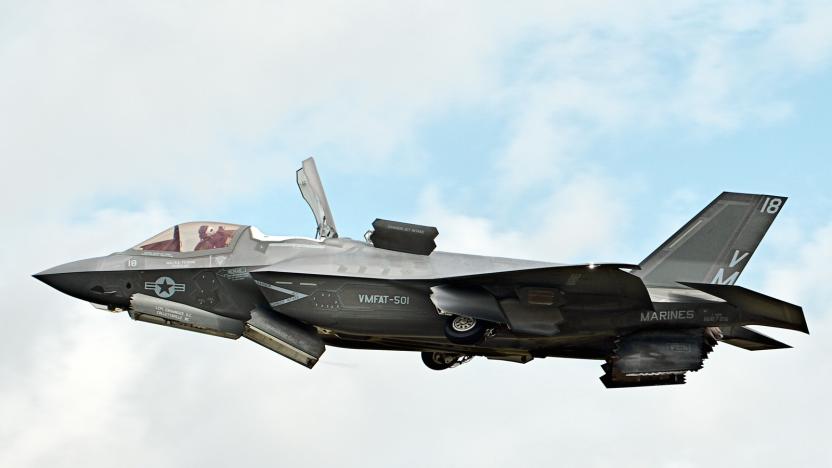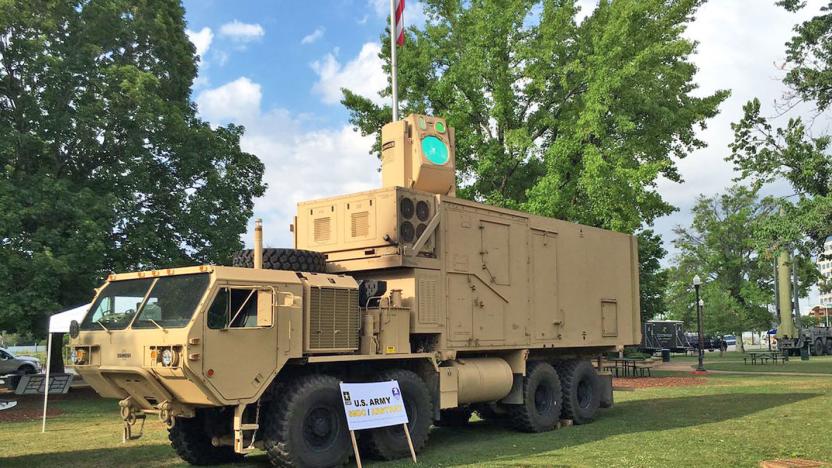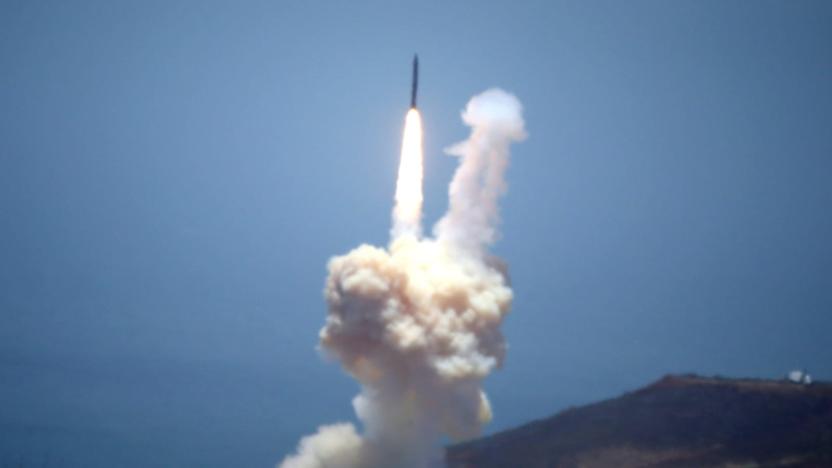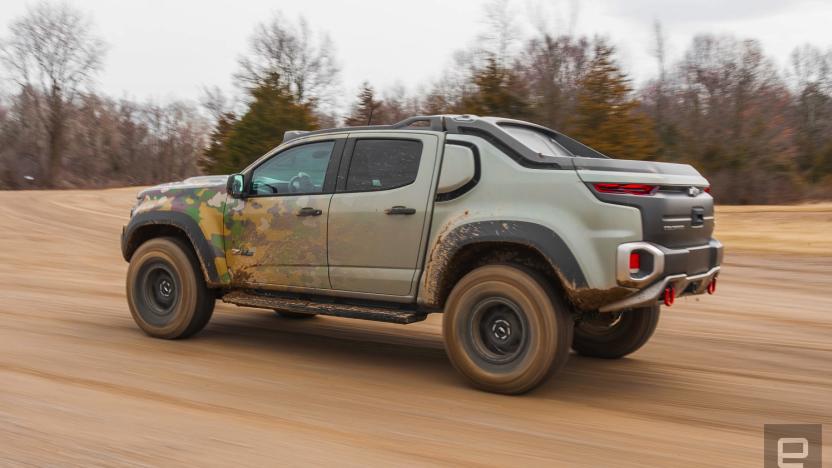wargadget
Latest

US took down Iranian drone using new jammer technology
When the USS Boxer took down an Iranian drone in the Strait of Hormuz, it apparently represented a baptism by fire for new technology. The Wall Street Journal understands that the action was the US Navy's first use of MADIS (Marine Air Defense Integrated System), an anti-drone system adapted for the sea. The technology uses jammers to block a drone's communications and force it to crash. Some versions of MADIS can also fire at the drones, although it's not clear that was the case here.

US Army to test robotic combat vehicles in 2020
The US military is about to try using robotic vehicles in a more aggressive fashion -- the Army will start testing robotic combat vehicles in 2020. Soldiers in two modified Bradley Fighting Vehicles (Mission Enabler Technologies-Demonstrators, or MET-Ds) will remote control four crewless M113-derived prototypes to gauge how well the system works in real life. While it's not a combat situation, the Army hopes for feedback that will reveal problems or different use patterns.

US Navy's next-gen helicopter drone is ready for service
It took a few years, but the US Navy's beefier Fire Scout helicopter drone is finally ready for action... more or less. The military branch has declared that Northrop Grumman's MQ-8C has reached "initial operational capability," or the minimum state it needs to enter service. The new, Bell 407-based variant is considerably larger than its 8B predecessor, but it's also more capable. The 8C can last roughly twice as long in the air at 12 hours on station, and carry roughly three times the payload -- 701lbs, to be exact. It also packs new radar with a larger field of view and more modes, including air-to-air targeting.

Russia says it will give soldiers bomb-carrying drones
Never mind using small drones for battlefield recon -- if Russia has its way, they'll be another part of the arsenal. The country's Defense Ministry recently told Izvestia that it's not only outfitting platoons with small drones, but will eventually outfit these drones with weapons. There are already "miniature bombs" in development, the Ministry said. The move was apparently a response to experiences in Syria, where ISIS tried attacking a Russian base with commercial drones (such as the one pictured above) modified to carry explosives.

Germany and the Netherlands form a joint military network
Networking on the battlefield won't just be limited to communication between units for one country. Germany and the Netherlands have created a joint military network, TEN (Tactical Edge Networking), that helps soldiers from the two countries coordinate their operations. They'll even share computers, radios, telephones and other equipment. TEN will initially link Germany's land operations with the Netherlands' tactical communications program.

CIA 'Ninja bomb' replaces explosives with six long blades
The US apparently has a unique approach to minimizing bystander casualties from drone strikes: replace the warhead with old-fashioned knives. The Wall Street Journal has learned that both the CIA and the Pentagon have been using a variant of the Hellfire air-to-ground missile, the R9X (aka "Ninja bomb"), that deploys six blades moments before impact to cut through virtually anything in its path, including buildings and cars. The idea is to take out a terrorist leader or a similarly prominent target without risking the lives of nearby civilians.

US Air Force successfully shoots down multiple missiles with a laser
The US Air Force just edged closer to its goal of outfitting aircraft with laser weapons. Testers at the White Sands Missile Range have successfully shot down multiple air-launched missiles using the Self-Protect High Energy Laser Demonstrator (SHiELD), proving that it can hold up under intense situations. While SHiELD is currently a ground-based behemoth (see below), the finished technology should be portable and rugged enough to be used aboard aircraft.

Russia tested a hypersonic missile it claims will beat all defenses
Russia might have advanced the development of a hypersonic missile system. State-backed media reports that the Defense Ministry has successfully tested Avangard, which mates an ICBM with a glide vehicle that travels up to Mach 5. Officials say they launched the missile from the Orenburg area (near western Kazakhstan) and hit a target thousands of miles away at a test range in Kamchatka. Not surprisingly, the test was conducted on orders from President Putin.

DARPA wheels change from tires to tracks without stopping
Travel across difficult terrain usually involves a lot of compromise. Tracks will get you where you need to go, but they're slow whenever you're covering open ground. DARPA, however, doesn't think you should have to make that choice. It's working with Carnegie Mellon University on Reconfigurable Wheel-Track technology that converts wheels from tracks to tires (and vice versa) in the middle of a drive. As you can see in the clip below, the change takes just two seconds -- you could drive off the road and up a hillside without skipping a beat.

Navy backs 'omniphobic' coatings to help ships travel farther
Researchers have already explored the idea of using water-repellent ship coatings that let ships travel faster and farther. The US Navy, however, is taking things a step further. It's backing University of Michigan work on an "omniphobic" coating that shrugs off virtually any liquid (it'll even fend off peanut butter) while lasting for a long time. Ships could theoretically glide through the water without nearly as much friction as ordinary vessels, consuming less fuel and traveling longer.

Korean university faces boycott over fears of AI weapons
For all the joking we do about Skynet-scenarios and killer robots, there's some truth to the worrisome creations. To prevent Terminators from becoming a real threat, some 50 robotics experts are boycotting the Korea Advanced Institute of Science and Technology (KAIST), a university in South Korea, given its decision to open an artificial intelligence weapons lab, according to Financial Times. The fear is that it'll trigger a next-gen arms race and that ultimately, any safeguards put in place will be circumvented by terrorists and, more specifically, North Korea.

Boeing shows its vision for a hypersonic spy aircraft
Lockheed isn't the only one hoping to make a hypersonic spy aircraft. Boeing has provided early details on its own design for a hypersonic tech demonstrator that would lead to a spiritual successor to the SR-71 Blackbird. In some ways, it's a logical extension of the company's X-51A Waverider: the wedge-shaped, twin-tail body is designed to minimize drag while gulping in as much air as possible. It would be about as long as the Blackbird, but its Mach 5-plus top speed would leave the older Mach 3.2 jet far behind.

F-35 may see combat in 2018
After a very long and problematic development process, the F-35 Lightning II is about to serve on the front lines. The US Marine Corps is deploying the F-35B (the short takeoff and vertical landing variant) to ships in the Central and Pacific Command theaters in the spring and summer of 2018. The 13th Marine Expeditionary Unit is traveling aboard the USS Essex, which is headed to the Middle East, while the 31st will be attached to the USS Wasp and might head to the coast of North Korea.

Rolls-Royce unveils plans for an autonomous patrol ship
Patrol ships are necessary to protect coastlines and fleets, but they're far from ideal right now. You need big, bulky vessels, and the human crews are either faced with the tedium of an uneventful trip (if they're lucky) or threats that a lone ship is ill-equipped to face. Rolls-Royce might have a better way: it just unveiled plans for an autonomous patrol ship that would eliminate many of these headaches, and would even be relatively eco-friendly.

US Army wants helicopters to refuel at robotic pumps
Militaries regularly set up fueling stations at forward bases so that helicopters can get back to the fight as quickly as possible. However, requiring fuel crews creates huge risks and logistical headaches: you're sending people to a dangerous, isolated section of the battlefield for a fairly mundane role. Thankfully, the US Army might not need to take that risk for much longer. It's testing an unmanned station, the Autonomous & Robotic Remote Refueling Point (AR3P for short), that can top up a helicopter with no human involvement. Much like Tesla's robotic charger, it would use self-aligning, articulated arms to hook a fuel line to a helicopter all by itself. That, in turn, would let helicopters fly at all hours without putting footsoldiers in harm's way, and would likely refuel them faster.

US Army expects to take down planes with anti-air lasers
Forget shooting down drones with vehicle-mounted lasers -- the US Army is ready to take on the bigger machines. Space and Missile Defense Command chief Lt. Gen James Dickenson has revealed that the Army is preparing lasers that are ten times more powerful than the ones in testing now, at between 50kW to 100kW. That kind of wattage is strong enough to take down aircraft, and might even throw missiles off their targets by confusing their sensors. They won't necessarily require gigantic trucks like they do today, either.

US and Australia finish a key round of hypersonic missile tests
The US and its allies are determined to be first out of the gate with hypersonic weapons, and they've just taken a big stride forward in that regard... not that they're saying much about it. Both the US and Australia have confirmed that they recently completed a series of mysterious hypersonic missile tests. All the countries will say is that the flights were successful, and that they represented "significant milestones" in testing everything from the design assembly to the control mechanisms. They won't even say which vehicles were used or how quickly they traveled, although past tests have usually relied on Terrier Orion rockets (above) and have reached speeds as high as Mach 8.

US successfully shoots down a (simulated) ICBM
American missile defense systems haven't always worked out according to plan, but it's chalking up a major success right now. The Department of Defense reports that the Ground-based Midcourse Defense portion of its anti-ballistic missile system has managed to shoot down an "ICBM-class" target during a test. The dry run saw a ground-based interceptor rocket (above) launch from California's Vandenberg Air Force Base and use an exo-atmospheric kill vehicle (a 5-foot machine deployed from the tip of the rocket) to take down the simulated weapon while it's in space. This is the first live-fire test of GMD, the Defense Department says, and it shows that the US has a "capable, credible" deterrent against intercontinental missiles.

American special forces open a drone hacker lab
Battlefield drones are evolving quickly, and there's only so much militaries can do to keep up -- they're not used to competing with consumer tech that can improve in a matter of months. To that end, US Special Operations Command (aka SOCOM) is taking the unusual step of opening a drone hacker lab in Tampa, Florida at an unspecified point in the future. The organization's James Geurts hopes this tinkerer mindset will help special forces "get out in front" of threats that could easily prove overwhelming, such as drone swarms. There are also more direct problems to solve, such as balancing weapon payloads and portability. You may need a drone bigger than something like the tiny, kamikaze-oriented AeroVironment Switchblade (above) to take down a target, but you can't always field more conventional runway-bound drones to do the job.

The Army could save hydrogen cars from a premature death
Over the past 25 years, hydrogen fuel cells (HFC) have been the butt of countless jokes in the automotive industry. Many critics see the technology as something long in the works that will never have a future. It's seen some spotty progress over the past decade, existing alongside compressed natural gas vehicles. But in terms of public perception, HFCs are still on the fringe compared with plug-in hybrids and electric vehicles. In 2016, the Los Angeles Times reported that Toyota expected to sell 3,000 of its $60,000 Mirai sedans by the end of 2017 -- and that was an optimistic forecast, mind you. In contrast, Tesla racked up over 232,000 preorders for its all-electric Model 3 sedan in just 24 hours, and Toyota crossed 3.9 million in global sales for the Prius in February.

